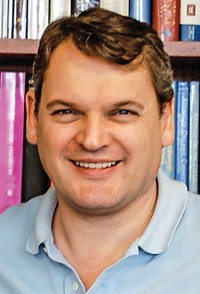Advertisement
Grab your lab coat. Let's get started
Welcome!
Welcome!
Create an account below to get 6 C&EN articles per month, receive newsletters and more - all free.
It seems this is your first time logging in online. Please enter the following information to continue.
As an ACS member you automatically get access to this site. All we need is few more details to create your reading experience.
Not you? Sign in with a different account.
Not you? Sign in with a different account.
ERROR 1
ERROR 1
ERROR 2
ERROR 2
ERROR 2
ERROR 2
ERROR 2
Password and Confirm password must match.
If you have an ACS member number, please enter it here so we can link this account to your membership. (optional)
ERROR 2
ACS values your privacy. By submitting your information, you are gaining access to C&EN and subscribing to our weekly newsletter. We use the information you provide to make your reading experience better, and we will never sell your data to third party members.
Synthesis
ACS Award For Creative Research & Applications Of Iodine Chemistry
Sponsored by SQM S.A.
by Jyllian N. Kemsley
January 31, 2011
| A version of this story appeared in
Volume 89, Issue 5

When Viktor V. Zhdankin was in seventh grade, a home chemistry kit enabled him to make nitrogen triiodide, which releases a cloud of purple smoke when it detonates. “That’s how I got really interested in iodine chemistry,” he says. “It became my favorite chemistry.”
Zhdankin, 54, went on to receive a Ph.D. in chemistry from Moscow State University, in Russia, in 1981. His doctoral research in the laboratory of Nikolay S. Zefirov was on the nucleophilic reactivity of perchlorate anions.
After finishing his degree, Zhdankin stayed at Moscow State as a research fellow. Trying to extend his doctoral research, he started experimenting with periodate. The compound didn’t work as a nucleophile, but he discovered other “rich and exciting chemistry” of hypervalent iodine reagents, in particular that they tend to be strong electrophiles and good oxidants.
Zhdankin came to the U.S. in 1987 as an exchange scholar to work at the University of Minnesota Duluth. He then did postdoctoral research with Peter J. Stang at the University of Utah before returning to Duluth as a professor in 1993. He’s been at Duluth ever since, continuing his research into iodine reagents for organic synthesis.
“Iodine(III) and iodine(V) reagents in general replace the heavy-metal oxidants, such as derivatives of lead, mercury, thallium, and chromium,” Zhdankin says. “The advantage is that iodine works better as an oxidant and electrophilic reagent, and it’s not toxic at all.” Most recently, he has been developing hypervalent iodine compounds that can be used as catalysts for C–C bond formation and other reactions. “In the future, hypervalent iodine may replace palladium and other transition metals,” Zhdankin says. (It should perhaps be noted that, despite Zhdankin’s early interest in explosive iodine compounds, he now focuses on developing stable, safe reagents.)
Notably, he does his research at a primarily undergraduate institution. “Zhdankin nevertheless directs one of the most visible research groups focused on iodine chemistry in the U.S.,” says John D. Protasiewicz of Case Western Reserve University. “His work has had considerable impact on understanding the structure, reactivity, and applications of iodine reagents in organic synthesis.”
“Developments in the chemistry of hypervalent iodine are becoming increasingly important in synthetic methodologies. Zhdankin brings to this field an understanding that others have missed,” adds University of Maryland chemistry professor Michael P. Doyle, who calls Zhdankin’s accomplishments “extraordinary.”
Zhdankin is one of the few U.S. scientists elected to the Japanese Society of Iodine Science. Zhdankin has received a Camille & Henry Dreyfus Teacher-Scholar Award and several University of Minnesota awards for teaching and research.
Zhdankin will present the award address before the ACS Division of Organic Chemistry.





Join the conversation
Contact the reporter
Submit a Letter to the Editor for publication
Engage with us on Twitter